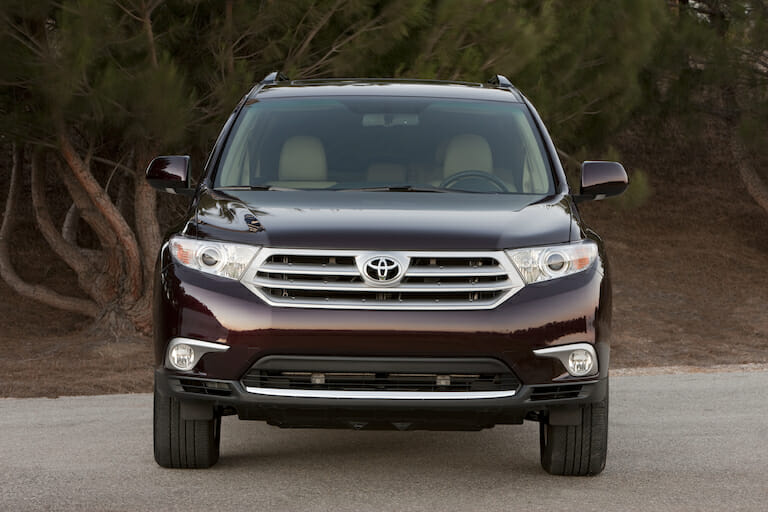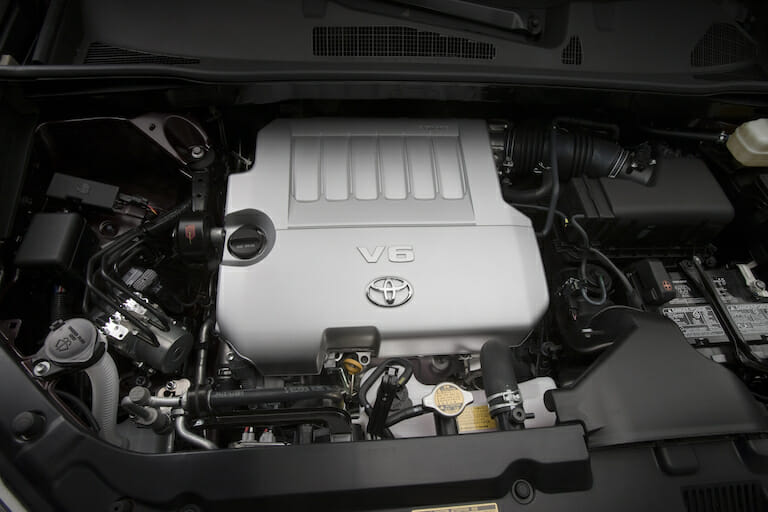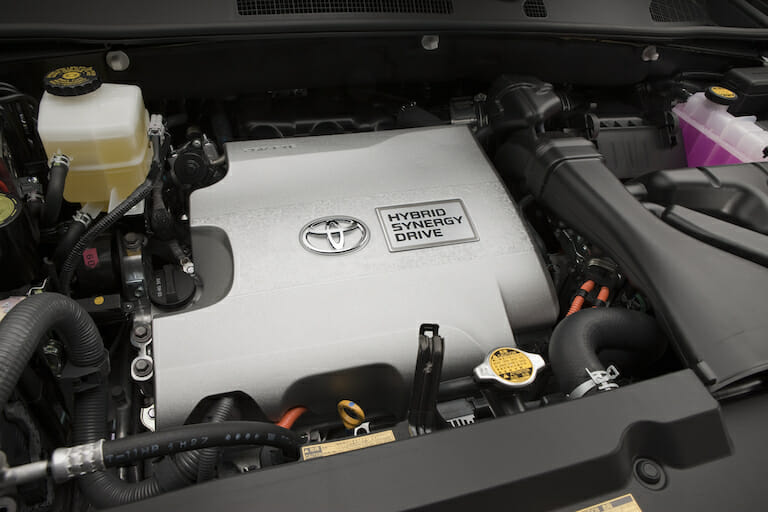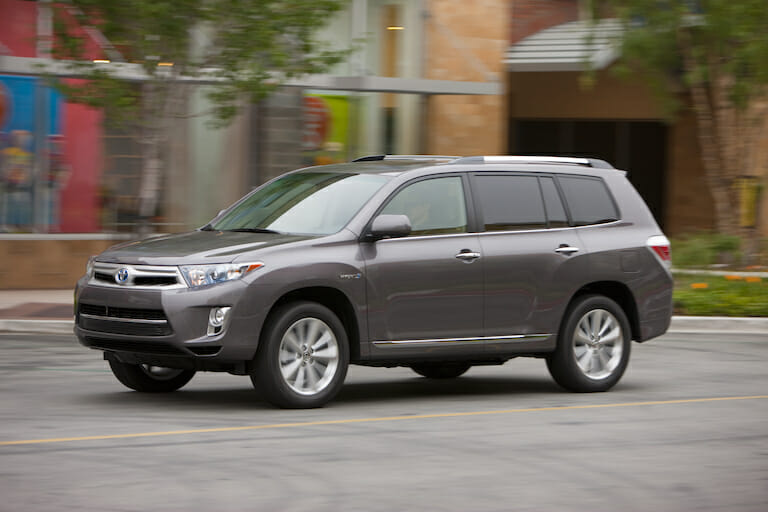The 2013 Highlander’s choice of naturally aspirated and hybrid engines aren’t as sophisticated nor efficient as some of its competitors. They miss out on cylinder deactivation and direct-injection technology but instead offer unmatched reliability and excellent engine life.

Key Points
- The 2013 Toyota Highlander has three engine options: a 187 horsepower 2.7L four-cylinder, a 3.5L V6 with 270 horsepower, and a 231-hp V6 hybrid.
- Transmission options are five-speed, six-speed torque converter automatics, and a CVT. All but the 2.7L engine is available with 4WD.
- Tow ratings are up to 5,000 pounds for the V6 when properly equipped, and 3,500 for the 2.7L and V6 hybrid.
- All three engines are very reliable. However, a small number of customers have reported blown head gaskets and oil leaks.
- Fuel efficiency is not a strong point of the Highlander. The 2.7L returns 20 mpg city, while the V6 gets 18. The hybrid is the most efficient, rated at 28 mpg city, highway, and combined.
- For city driving, the hybrid works great. However, if it’s performance and towing you want, get the V6. For light to moderate use, the inline-four is worth considering.

2013 Highlander’s 2.7L Inline-four isn’t the Most Refined, Offers Decent Fuel Economy by Midsize SUV Standards
Found in the Base and SE trims, the 2.7L inline-four is the standard engine option in the 2013 Highlander lineup. While outputs are respectable at 187 horsepower and 186 lb.-ft. of torque, the engine isn’t the most refined. You may notice the motor becoming noisy and stressed when under load.
Internally called 1AR-FE, the four-banger comes with Toyota’s VVTi variable valve technology, offering a decent mix of fuel economy and power. As standard, the engine is capable of towing 1,500 pounds, spec it with the optional towing package, and the capacity jumps to 3,500.
Fuel efficiency is not bad by midsize SUV standards. The 2013 Toyota Highlander 2.7L is EPA-rated at 20 mpg in the city, 25 mpg on the highway, and 22 mpg combined.
The only powertrain option is a six-speed automatic. But perhaps more disappointing would be the lack of 4WD in this engine configuration. That’s not to say FWD isn’t exciting. It’s just that the dynamics are fairly neutral; pair that to a modest drivetrain, and it’s pretty much a boring affair.
What you will appreciate is the engine’s robust nature. Although the NHTSA has three recalls against the 2013 Highlander, none are engine-related. That said, a small number of customers have reported blown oil cooler hoses, leading to oil leaks. Speaking of which, the 2.7L engine takes 4.6 quarts of 0W-20 oil.
Should you need the engine replaced, a refurbished 2.7L will set you back upwards of $4,000. However, used engines are slightly cheaper and cost around $3,000.

Toyota Highlander’s 3.5L V6 is a Powerhouse, Gets Optional 4WD, and Better Tow Ratings
Standard on the top-spec Limited, and optional on Base and SE models, the 3.5L V6 is powerful and refined. The V6 is so smooth that the only way to know it’s running at idle is to tap the pedal, a common observation by many auto journalists.
As for specs, the 3.5L outputs 270 horsepower and 248 lb.-ft. of torque. Internally called 2GR-FE, the V6 is tuned for utility and performance. Of course, it’s no sports car, but versus the inline-four, the V6 is definitely more exciting. 0-60 takes 7.1 seconds, and the engine can tow up to 5,000 pounds.
Sadly, the V6 Highlander doesn’t handle any better, mainly due to its high-riding nature and softly sprung suspension.
Unlike the 2.7L, the V6 is available in both FWD and AWD configurations. But what is a downgrade, though, is its gearbox; the only available transmission is a five-speed automatic.
Where the engine falls short is fuel economy. The EPA rates the 2013 Highlander V6 at 18 mpg city, 24 mpg highway, and 20 mpg combined.
The 3.5L engines require 6.4 quarts of 0W-20 oil at each service. Although there are a few complaints about cracked head gaskets and oil consumption, the issues are not too common nor overly worrying.
If you’re looking to replace the engine, refurbished units are worth around $5,500. Used V6s, on the other hand, run a couple grand cheaper and should be a better choice.

2013 Toyota Highlander’s 3.5L V6 Hybrid is All About Efficiency, Offering Up to 28 City MPG
Known internally as the 2GR-FXE, this 3.5L V6 runs the Atkinson cycle and is tuned with efficiency in mind. The 2013 Highlander hybrid is rated at 231 horsepower and 215 lb.-ft. of torque. Also, the engine is paired to a CVT rather than a torque converter automatic.
Apart from visual differences, there are other noticeable changes in the Highlander hybrid. For instance, the fuel tank capacity is 17.2 gallons, two gallons less than the non-hybrid models. Also, the vehicle weighs more thanks to the addition of a battery pack.
This V6 is paired with two electric motors, one on each axle, making it all-wheel drive. But the reduced output and added weight take a toll on its performance. The model’s 0-60 time is two-tenths slower, while towing capacity is limited to 3,500 pounds.
The real advantage of the V6 hybrid is fuel economy. With EPA ratings of 28 mpg city, highway, and combined, the Highlander hybrid is as efficient as a midsize sedan from 2013.
Replacing the battery pack can be a costly exercise. A new nickel-metal hydride (NiMH) battery costs around $3,000, and that’s before labor.

Despite Being the Least Economical, the Toyota Highlander’s 3.5L V6 is the Better Pick
From an efficiency standpoint, the hybrid makes more sense. However, we’d probably skip it, considering how expensive things can turn out should the battery or one of the motors fail.
The 2.7L inline-four simply isn’t powerful enough for a vehicle this size. The V6 is more capable, has better tow ratings, and isn’t too far off from the 2.7L in fuel economy.
The choice really boils down to your need. For city driving, the hybrid edition sounds ideal. If it’s performance and towing, get the V6. For light to moderate use, the inline-four should have you covered.
Regardless of the engine you pick, it’s going to be dependable. After all, it’s a Toyota.
Photos: Toyota
